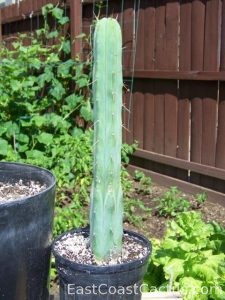Back around 2009 I purchased my first “San Pedro” cutting from an online auction site. The seller told me he picked up the plant in Arizona and it was Pachanoi variety. It has very short spines, grows fast, and puts out lots of pups from the base.
Then I started thinking about getting serious about raising and breeding cacti for FUN and profit and ran into a simple problem- with all the different varieties of Trichocereus cacti available on the big online websites how could I be sure what I was buying was correctly identified? So I found a grower who purchased his seeds from a reputable German cactus seed seller called Koehres and bought 10 seedlings from him. I got two each of varieties Bridgesii, Pachanoi, Peruvianus, and Macrogonus. He also sent me free two seedlings -one is definitely Bridge and one is definitely Peruvianus.. The reason for getting two each is because (as far as I know) Trichos are self sterile and you need to get pollen from a separate plant in order for them to set fruit and create more seeds. At least that is the way my Cereus Peruvianus cactus is as I have had hundreds of flowers but no fruit yet.
The plan was to create “pure” seeds by putting pollen from one Bridgesii on the other Bridgesii flower, same for Pachanoi, etc. Then I could offer guaranteed variety seed, and have records and photos of both of the parents. And of course experiment with hybrids and try to create offspring with extra vigor and other interesting characteristics. The problem with this plan is that these cactus take a LONG time to mature and put out flowers, and also would have to have at least two of the same variety flowering at exactly the same time. And the flowers only bloom for a night or two. My biggest cactus so far is around 6′ tall and no flowers yet….
I can now compare how Koehres Tricho seeds develop:
When small both Bridgesii seedlings looked identical but as they get older there are distinctive differences that are not just due to environmental issues like the pot size and soil mixture. My Bridgesii “001″ cuttings look just like the classic photos of the variety found online. It grows fast and is not a fat cactus- even at 6′ tall the widest part is only around 4” and must be supported, although that may be due to the fact that is does not ever get a full day’s sun. It has pretty long spines and what I would call an “angular” look. It is usually a paler green.
My Bridgesii “002” started out looking like the first one but as the cuttings got older noticed differences. For one thing it grows slower and is much more susceptible to over-watering- will get the black spots on it if too much water. The top has a more rounded look than the 001 and usually ends up with only one or two spines per areola. And the spines often fall off during slower growth times giving the top an almost smooth look.
That’s enough for today, tune in soon for details on the FAT Peruvianus from Koehres.
Ed
If you’d like to add a comment or reply to this post click on the title above and you will go to a page with the comment form



Not impressed at all. Maybe you should get a real job
can u help me? I want buy cactus